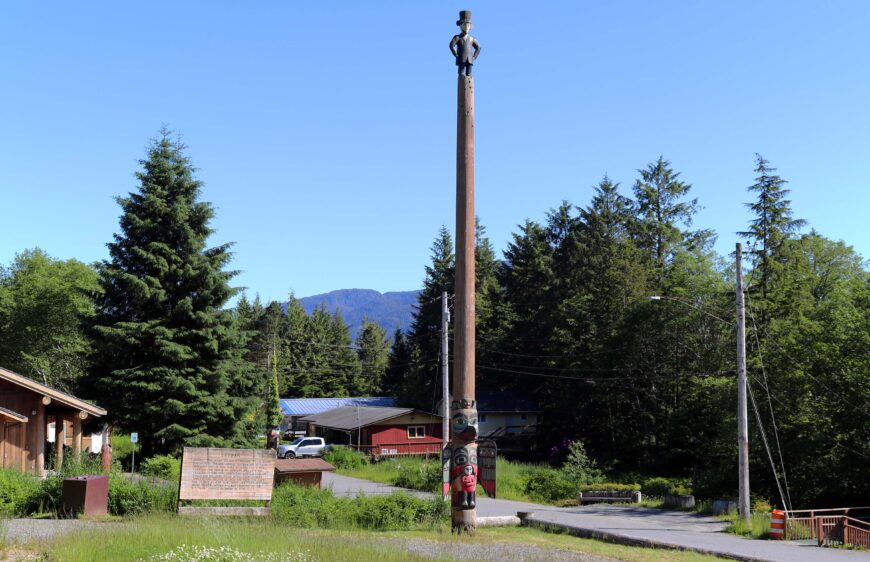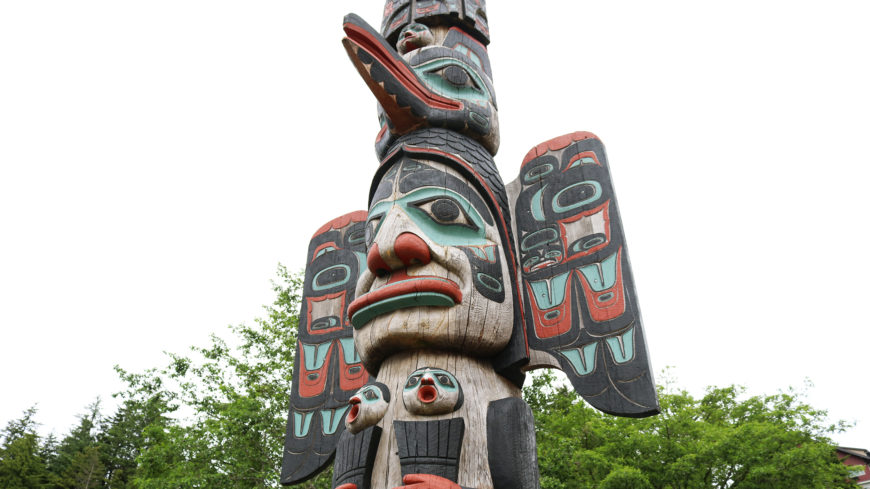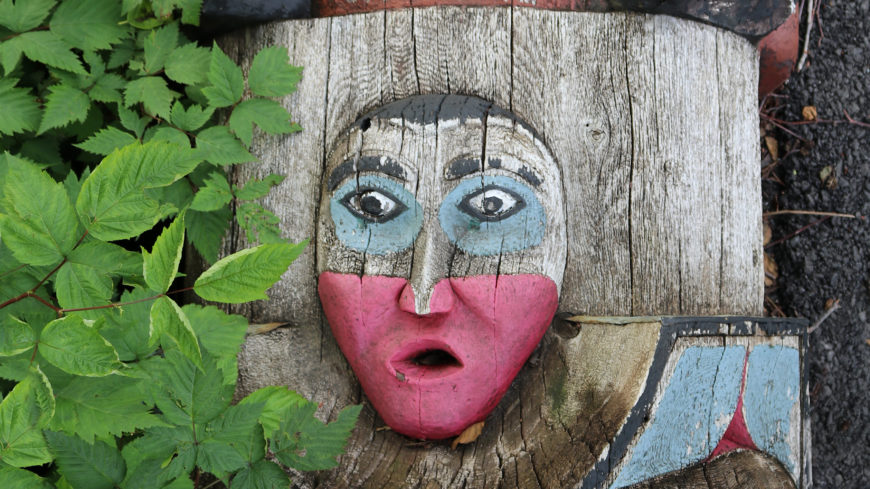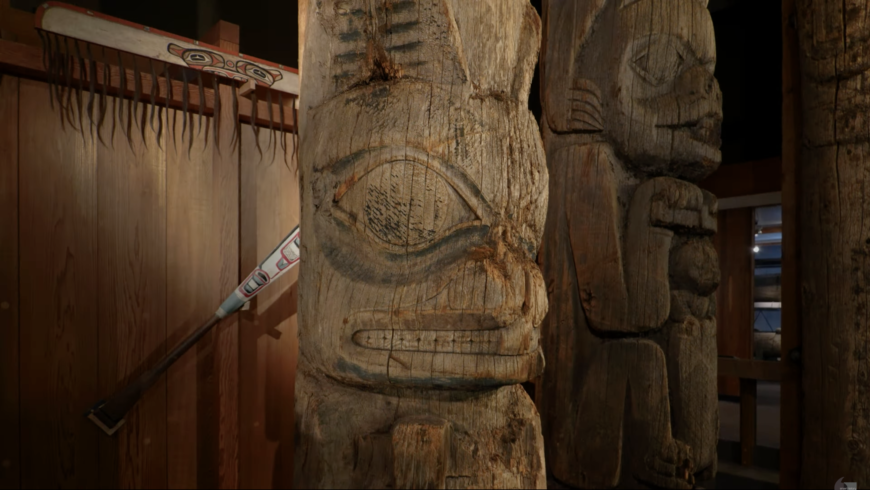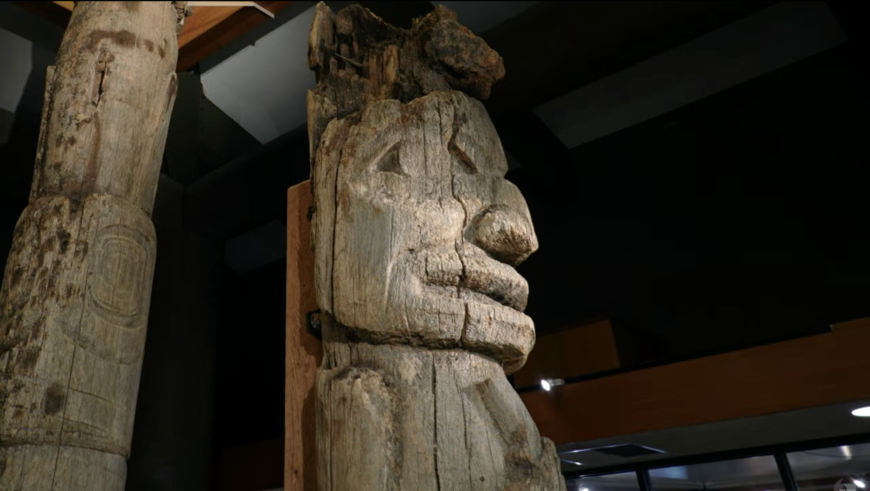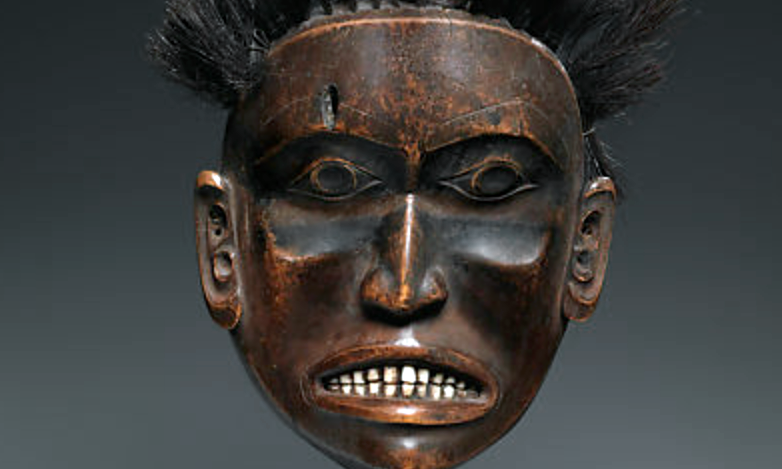A totem pole records Tlingit claims to land by acknowledging the first sighting of a white man, who is based on the likeness of Abraham Lincoln.
Proud Raven Totem Pole of the Taantʼa kwáan Gaanax.ádi clan of the Raven moiety, first carved in the 1880s, recarved c. 1940 as part of a CCC project, Saxman Totem Park, Saxman, Alaska. A Seeing America video; speakers: Dr. Emily Moore and Dr. Lauren Kilroy-Ewbank. Gunalchéesh (thank you) to Joel Buchanan, clan leader of the Taantʼa kwáan Gaanax.ádi Tlingit, for permitting us to share his clanʼs story. Thank you to the City of Saxman for permitting us to record in the Saxman Totem Park.
This totem pole has long been known as the “Lincoln Pole” because of the likeness of Abraham Lincoln at the top; however, according to most Tlingit elders, it was a depiction of the first white man seen in Tlingit territory in the 18th century. A century later, in the 1880s, a man from the Gaanax.ádi Raven clan of the Tongass Tlingit commissioned the pole to commemorate his ancestorʼs pride to have seen this first white man (which had become a Gaanax.ádi crest), using a photograph of Abraham Lincoln as the model for a generic white man. It is important not only for these various readings of the crests but also because it claims Gaanax.ádi clan territory before the first white men came to their shores—territory that Tlingit men who were recarving the pole in the 1940s were trying to assert to the U.S. government as their sovereign lands.
[0:00] [music]
Dr. Lauren Kilroy-Ewbank: [0:06] We’re at the Saxman Totem Park, and we’re standing in front of an enormous raven. This is the “Proud Raven Pole” that has also come to be known as the “Lincoln Pole.”
Dr. Emily Moore: [0:16] The base of the pole is more important for Tlingit people. It shows the crest of the G̱aanax̱.ádi clan from the Taantʼa ḵwáan Tongass people. This pole was originally erected in the 1880s on Tongass Island. It depicts at the bottom this beautiful raven carving with outstretched wings. These wings are appended when the carver added them to the main shaft of the pole.
[0:42] On his breast is this human figure with crossed arms. If you look carefully, the legs of the human figure morph into those of the raven. This was a person of the G̱aanax̱.ádi clan, of this raven crest, who almost becomes one with that crest.
Dr. Lauren Kilroy-Ewbank: [0:59] While we’re seeing about 30 to 40 feet of this pole rising from the ground, it actually goes into the ground. We’re not entirely sure how deep it goes, but some went down as deep as 18 feet to stabilize the pole.
[1:13] If we look above the “Proud Raven,” we see an undecorated shaft. And as we lift our eyes to the top of the pole, we find the figure of Abraham Lincoln.
Dr. Moore: [1:23] This was a likeness of Lincoln. This is what captured the attention of non-Natives. In the 1920s, there was a famous Alaskan judge who published a story about this pole being a memorial to Lincoln, that Tlingit people were so grateful to Abraham Lincoln for having emancipated slaves.
[1:43] Actually, what Tlingit elders emphasized instead was that this was never a memorial to Abraham Lincoln. This pole was a record of the pride of the G̱aanax̱.ádi Raven Clan at having been the first to see a white man in Tongass territory.
[2:01] This encounter probably took place in the late 18th century, during the fur trade, when Spanish, English, and American ships were plying the waters of Southeast Alaska for sea otter pelts. This particular encounter for the Tongass people probably took place on Duke Island, again, south of Ketchikan.
[2:22] It overlooks the broad expanse of the open Pacific Ocean, where it would have been very likely they saw one of these European sailing ships. Maybe a century later, this pole was erected in the 1880s on Tongass Island to commemorate that encounter and to recall the pride of the G̱aanax̱.ádi Ravens at having been the first to see this white man on their territory.
Dr. Lauren Kilroy-Ewbank: [2:44] When this pole was erected in the later 19th century, Lincoln has recently been assassinated, the Civil War has ended, Lincoln has cast this really large shadow on people’s imaginations.
[2:56] It’s not surprising to me that non-Native people would get very excited at this story that you mentioned earlier, this idea of Lincoln, the great American hero, but really, it has a very different meaning for the local Indigenous people. It becomes a record of sovereignty, their claim to the land.
Dr. Moore: [3:13] Right, they were here before these first white men ventured to their shores.
[3:18] The photograph that was probably used was a photograph taken during the Civil War of Abraham Lincoln standing at Antietam. In those photographs, he’s standing with his arms clasped behind his back. The carver interpreted this as arms akimbo.
[3:35] This first white man standing at the top of this pole, this image of Abraham Lincoln, was likely given to them as a diplomatic gift on Tongass Island. Because Tongass Island was not only the site of a prominent Tlingit village, but also the first US military base built in Alaska after the United States purchased Alaska from Russia in 1867.
[3:58] In this really complex time of transition, with Americans arriving on the scene, claiming the land, Tongass Tlingits erect this pole that claims their sovereignty on this land that Americans are now claiming, that looks back to a time when they were the first to see white people coming to their shores.
Dr. Kilroy-Ewbank: [4:18] When the Saxman Totem Park was constructed in the 1930s during the Great Depression, when the US Forest Service and the local Native communities were coming together to create this park — in part to appeal to tourists, to appeal to people who would be passing by the park on steamships, who could see the totem row as it ascends up the hill — it makes sense to me that they would continue to draw up support for this myth of Lincoln as the emancipator, as the savior of people.
Dr. Moore: [4:46] It’s interesting because this pole was one of the catalysts for the Totem Pole Restoration Program.
[4:52] When the Forest Service first applied for money, New Deal officials labeled this request to restore totem poles in the remote islands of Southeast Alaska as the “boondoggliest of boondoggles,” this watchword for needless spending during the Great Depression.
[5:09] And yet, when they saw that there was a Tlingit pole that depicted Lincoln, this was the selling point, this was something everyone could agree should be preserved.
[5:19] What’s really important is that the story became known that this was not a memorial to Abraham Lincoln, but instead this document of G̱aanax̱.ádi pride, of their sovereignty, their clan history on this land long before white people arrived.
[5:34] [music]


